How to Choose a Livestock Guard Dog
Not just any dog has the instincts for the job. Dedicated, wise, and noble, LGDs are less a pet than an independent contractor.
How to Choose a Livestock Guard Dog
Not just any dog has the instincts for the job. Dedicated, wise, and noble, LGDs are less a pet than an independent contractor.
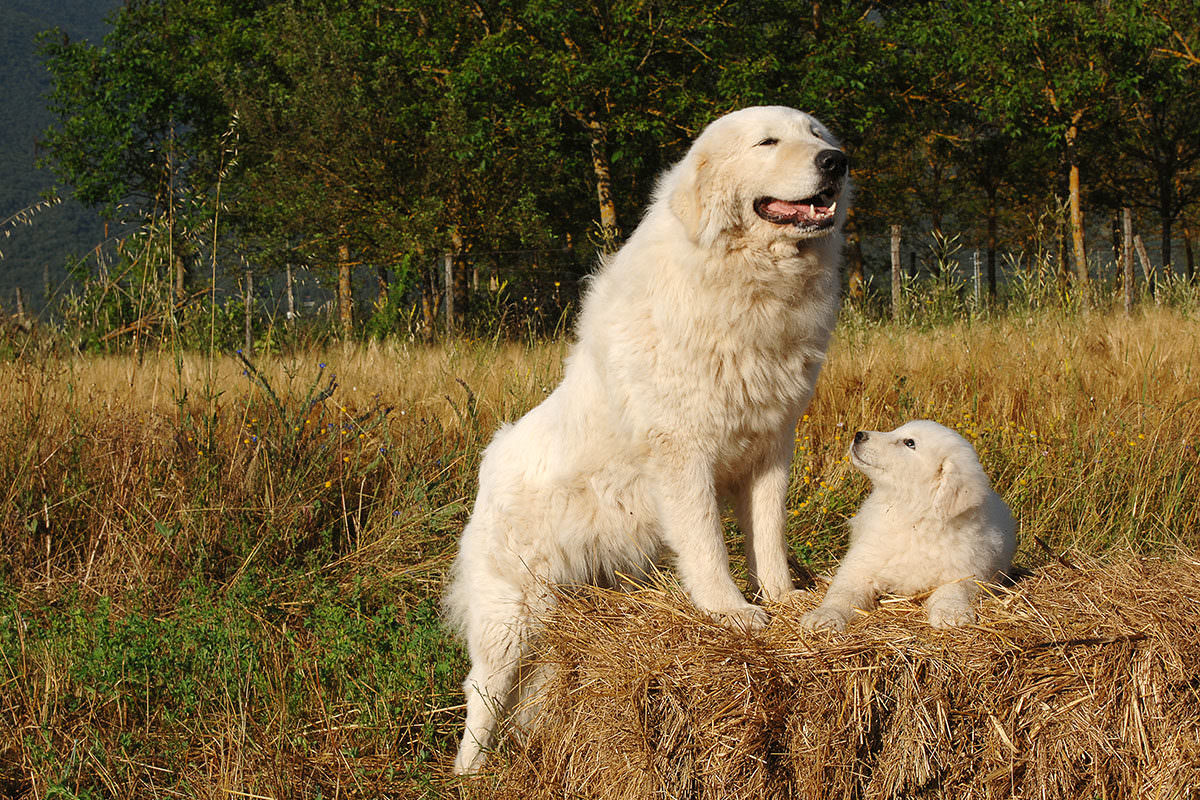
Besides sturdy fencing, guard dogs are the primary tool to prevent such horrors, not just with sheep, but goats, calves, chickens, ducks, and any other livestock small enough for a predator to take down. But it’s more than your four-legged coyotes, foxes, bobcats, wolves, and mountain lions you have to worry about, hawks and other birds of prey can easily nab poultry, even in urban areas, as can raccoons, skunks, and weasels.
Livestock guard dog (LGD) breeds are generally large (over 100 pounds), and while they may be devoted and friendly with their human owners, they are often unfriendly with other dogs. (A good canine guardian will also keep stray dogs – not to mention your neighbor’s mischievous cockadoodle – at bay.) LGDs are true work animals, and they cannot double as a traditional family pets if they’re expected to do their job. They have evolved a specific combination of traits that few other breeds possess: the ability to live outdoors year-round; a willingness to not harass, or kill, livestock, even when hungry; a highly developed sensitivity to livestock behaviors; and a skilled approach to detecting and deterring predators.
Best Guard Dog Breeds
Below are the LGD breeds most common in the U.S., though another dozen comparable breeds are available, too. All are suited for guarding virtually any type of livestock. There is no need to look for a purebred – many farmers find that offspring of two LGD breeds combine the best qualities of each. For protecting small livestock, such as poultry or rabbits, in which case the dog is typically kept outside the fence that contains the animals, non-LGD breeds may be suitable as long as they can be trained to live outdoors.

Great Pyrenees
These noble, independent, highly intelligent dogs are perhaps the most widely used LGD in America. Originally bred by the Basque in the mountains between Spain and France, they excel in wide open spaces; in small pastures, they may be tempted to dig out of fencing to satisfy their urge to roam. They do not accept vocal commands as readily as other breeds, but they’re considered more friendly with humans. Note: Great Pyrenees’ thick coat makes them a poor choice for hot, humid regions.
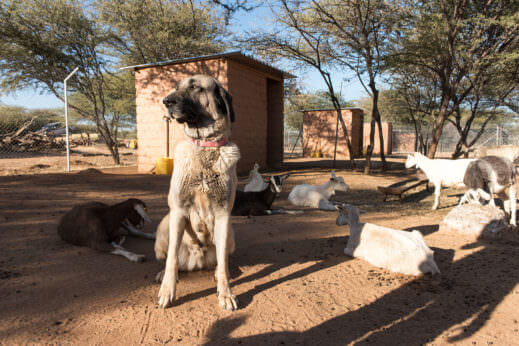
Anatolian Shepherd
This breed is muscular, imposing, and reserved in temperament. Originally from the mountains of Turkey, these dogs are unmatched in their devotion to the herd, but may not be particularly friendly toward humans. Some individuals may even dislike petting. Historically, Anatolians were often left alone with livestock for extended periods. They are capable of withstanding hot weather.
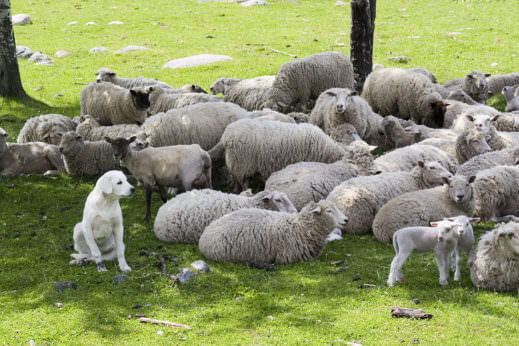
Akbash
Another Turkish breed, Akbash are all white, but vary considerably in hair length (one to eight inches) and build (both slender and stout individuals may be found). They are a bit smaller on average than most other LGDs, however.
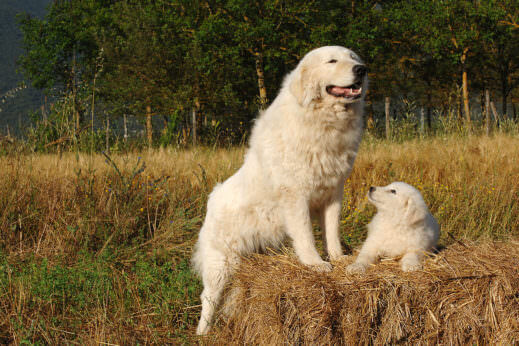
Maremma Sheepdog
Also referred to as Marremmano, this breed originated in the hills of central Italy and is quite small for an LGD (typically under 100 pounds). They are fiercely loyal to the herd, but fairly aloof with people.
Finding Your Guard Dog
Finding a good LGD is completely unlike finding a good pet, where it’s easy to find a lovable mutt from the local shelter who will readily befriend you for life. The best places to start are breed associations websites. These typically provide a list of reputable breeders across the country; don’t be shy about asking for references if there’s any doubt about their credibility. Another option is to contact farmers who own LGDs to see if they are selling puppies, or perhaps even a mature, trained animal that you can see in action prior to purchase.
The key is to find breeders that focus specifically on working animals, not show animals or pets – many LGDs are sold for the latter purposes, but you want a dog from a bloodline with proven guardian dog instincts. If possible, purchase a dog that has been raised by a working LGD among livestock, preferably the same species that you intend for it to work with. At the very least, the seller should be able to provide some evidence that the animal is descended from working dogs.
Avoid “bargains,” as there is usually a reason, whether poor health, undesirable temperament, or lack of training. You can expect to pay a minimum of $500 for a puppy and $1000 for an adult, and twice that for some of the less common breeds. One LGD may be all you need”“the livestock serve as their companions – but two or more are necessary for large herds on open ranges. If you have multiple herds kept in different locations, you’ll need at least one dog per herd.
Establishing the Dog with the Herd
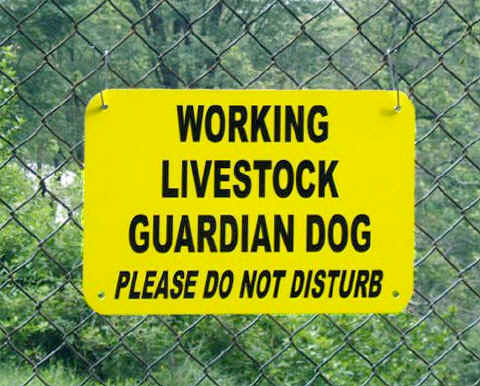
If you purchase a puppy, wait to bring them home until they are about two months old and then place them immediately with the livestock so they can start the bonding process – they must live with your livestock, not with you, from day one. It’s important to socialize LGDs with humans, as well, but it’s best to keep human contact to a bare minimum for the first couple of months.
The good news is that there is no need to train the dog to guard the herd – either they have the instincts or not. But don’t expect them to do much guarding during puppy-hood (they will want to play with the animals at first). Look for the protective instincts to kick in at around six months of age; they will continue to develop until the dog reaches adulthood at about two years. If a young LGD play-chases their livestock companions too aggressively, use verbal reprimands to discourage the behavior.
They will need a rain-proof dog house with soft bedding, such as cedar shavings. Sturdy fencing is critical on farms where the livestock are not roaming large, open ranges, as most LGDs instinctively want to patrol a large territory. The same fencing that contains your livestock may not do the same for your dog, who can dig and jump (electric fencing is often an effective deterrent for both, however). Post signs that say “Working Livestock Guard Dog – Do Not Disturb” along the fence line to warn passerby not to approach the dogs.
As a final note, expect a lot of nighttime barking – that means your LGDs are doing their job. But think twice before using LGDs where neighbors are in close proximity.
SaveSave
Follow us
This work is licensed under a Creative Commons Attribution-NoDerivatives 4.0 International License.
Want to republish a Modern Farmer story?
We are happy for Modern Farmer stories to be shared, and encourage you to republish our articles for your audience. When doing so, we ask that you follow these guidelines:
Please credit us and our writers
For the author byline, please use “Author Name, Modern Farmer.” At the top of our stories, if on the web, please include this text and link: “This story was originally published by Modern Farmer.”
Please make sure to include a link back to either our home page or the article URL.
At the bottom of the story, please include the following text:
“Modern Farmer is a nonprofit initiative dedicated to raising awareness and catalyzing action at the intersection of food, agriculture, and society. Read more at <link>Modern Farmer</link>.”
Use our widget
We’d like to be able to track our stories, so we ask that if you republish our content, you do so using our widget (located on the left hand side of the article). The HTML code has a built-in tracker that tells us the data and domain where the story was published, as well as view counts.
Check the image requirements
It’s your responsibility to confirm you're licensed to republish images in our articles. Some images, such as those from commercial providers, don't allow their images to be republished without permission or payment. Copyright terms are generally listed in the image caption and attribution. You are welcome to omit our images or substitute with your own. Charts and interactive graphics follow the same rules.
Don’t change too much. Or, ask us first.
Articles must be republished in their entirety. It’s okay to change references to time (“today” to “yesterday”) or location (“Iowa City, IA” to “here”). But please keep everything else the same.
If you feel strongly that a more material edit needs to be made, get in touch with us at [email protected]. We’re happy to discuss it with the original author, but we must have prior approval for changes before publication.
Special cases
Extracts. You may run the first few lines or paragraphs of the article and then say: “Read the full article at Modern Farmer” with a link back to the original article.
Quotes. You may quote authors provided you include a link back to the article URL.
Translations. These require writer approval. To inquire about translation of a Modern Farmer article, contact us at [email protected]
Signed consent / copyright release forms. These are not required, provided you are following these guidelines.
Print. Articles can be republished in print under these same rules, with the exception that you do not need to include the links.
Tag us
When sharing the story on social media, please tag us using the following: - Twitter (@ModFarm) - Facebook (@ModernFarmerMedia) - Instagram (@modfarm)
Use our content respectfully
Modern Farmer is a nonprofit and as such we share our content for free and in good faith in order to reach new audiences. Respectfully,
No selling ads against our stories. It’s okay to put our stories on pages with ads.
Don’t republish our material wholesale, or automatically; you need to select stories to be republished individually.
You have no rights to sell, license, syndicate, or otherwise represent yourself as the authorized owner of our material to any third parties. This means that you cannot actively publish or submit our work for syndication to third party platforms or apps like Apple News or Google News. We understand that publishers cannot fully control when certain third parties automatically summarize or crawl content from publishers’ own sites.
Keep in touch
We want to hear from you if you love Modern Farmer content, have a collaboration idea, or anything else to share. As a nonprofit outlet, we work in service of our community and are always open to comments, feedback, and ideas. Contact us at [email protected].by Brian Barth, Modern Farmer
September 14, 2017
Modern Farmer Weekly
Solutions Hub
Innovations, ideas and inspiration. Actionable solutions for a resilient food system.
ExploreExplore other topics
Share With Us
We want to hear from Modern Farmer readers who have thoughtful commentary, actionable solutions, or helpful ideas to share.
SubmitNecessary cookies are absolutely essential for the website to function properly. This category only includes cookies that ensures basic functionalities and security features of the website. These cookies do not store any personal information.
Any cookies that may not be particularly necessary for the website to function and are used specifically to collect user personal data via analytics, ads, other embedded contents are termed as non-necessary cookies.
I have to say after over 20 years working with LGD I will disagree on a few points made in the in the comments. Breeds denote dog types that have had reduced genetic diversity. Breeds tend to be bred to a standard and often as pets. I would strongly suggest you chose a dog type that is a landrace and NOT bred to any standard other than its working ability. Mixing “breeds” might be the best way to add genetic diversity to both lines and if the mixes are within the LGD dog type. Done this way you have nothing… Read more »
Never let LGD puppies play with livestock. Never let them chase livestock. Supervise their interactions closely, and separate them from livestock (as in a kennel enclosure in close visual contact with the livestock) when you cannot supervise them. Otherwise, you may find your puppies have been harmed by the livestock, or vice versa. Also, you may end up with huge adult dogs who think it’s OK to romp with the livestock, which may result in injuries to or death of livestock. Finally, it’s a myth that you or members of your family shouldn’t bond with LGDs. LGDs can bond with… Read more »
I find the dogs that are more social than working in their personalities I sell for pets instead of farm dogs. The problem I have is farm working dogs and city folks that think they should be inside during cold ,snowy weather.
Do your homework. We have been using guardians for several years successfully. We have our dogs with goats but they will work with what ever they imprint on as as a pup. We raise and sell purebred maremmas in swan river Manitoba canada. Talk to breeders or producers that have had success. A good breeder should happily answer your questions.
I have a concern about a LGD harming a family pet (I have dachshunds) or the neighbor’s dogs ( who is my sister, and she breeds beagles, she has said that she might need a LGD to keep her beagles safe). We have been having issues with Mountain Lions, coyotes and wolfs ( some of these dogs are hybrids mixed with wild domestic dogs) coons, human trespassers, some prey birds, Living in the southern heat and my familiarity with the Mountain Curs, I’m thinking that they are a great option for a couple of them. I’m just concerned that they… Read more »
What is the best guard for alpacas? I was also considering a Llama that I’m told are also good protectors. I’m looking to start will only about five but expect the herd to grow. What breed dog do you recommend?
Is there any Livestock guard dog that will react to a wireless exterior fence boundary? I have many small fenced areas with chickens, ducks, rabbits and soon goats. I want one dog to patrol the outer perimeter of this – but it is cost prohibitive to securely fence it all in. Just wondering if I have to wait for the secure fencing or if an invisible fence could work for any breed?
Looking for a LGD in AZ. We are on a ranch that is known to have mountain lions around quite frequently, as well as other predators (bobcats, bears, Fox, etc). Our temps can get up to about 105, where we are and lows around 20. We have sheep, llama and multiple fowl including peacocks. Please let me know if you have any trained adult dogs you’d like to sell, or pups that can handle this environment and workload. Thank you in advance!
I’m curious why The Pyrenean Mastiff was not mentioned??? They are world rated #1 LGDs.
Ok family. Here is what I need. I could really use your input. I have 7acres and no fence. I have neighbors on 3 sides. I want a dog to patrol my parameter and keep deer away, protect chickens and scare the hell out of anyone wanting to come near my little kid). BUT I have many friends that visit with dogs of their own. I have neighbors that collect mail at the head of my land. I someday hope to host airb&b guest on a corner of the land (strangers). What breed am I looking for? Am I asking… Read more »